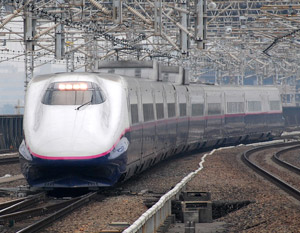リスク対応策 2020.03.29
RM 31 インドのシンカンセン Sinkansen (bullet train), India
For those who prefer to read this column in English, the Japanese text is followed by a British English translation, so please scroll down to the bottom of the Japanese text.
リスクを変化させる大きな要素は「時間」である。時間の経過とともに「自社」と「競合他社」、そして「市場環境」、これらすべてに複雑な変化が起き、一旦決定、実行している企業戦略に対して、その継続の可否を含め大きな変更を要求していく可能性があるからである。

本年2020年2月8日の「毎日新聞WEBサイト」には、以下の記事が掲載されていた。
日本の新幹線方式を採用するインド西部の高速鉄道建設計画で、日印両政府が、予定していた2023年の開業を5年程度遅らせる方向で調整していることが、両政府関係者への取材で明らかになった。計画地の土地収用の遅れに加え、設計変更の調整に手間取っていることが理由。政府開発援助(ODA)による事業費も当初予定の1・8兆円から少なくとも2兆円超へ膨らむ。今年前半にも安倍晋三首相とインドのモディ首相が会談し、最終決定するとみられる。
1.インドの「シンカンセン」
2019年12月15日付「産経新聞社WEB記事」には「『ビジネス解読』インド初の新幹線計画に暗雲 地元反対やコストで日本勢が『及び腰』」と題して、インドの新幹線計画に関する以下の記事が掲載されていた。
インド初の高速鉄道計画に採用が決まっている日本の新幹線方式の事業化に、暗雲が立ちこめている。反対運動で土地収用が難航。車両システムの受注が有力視される日立製作所や川崎重工業は、インドが現地生産にこだわる中、採算性を危ぶむ。こうした状況に、傘下の日本コンサルタンツ(JIC)が設計支援などで協力するJR東日本は「及び腰」になっており、官邸主導のインフラ輸出は戦略の見直しを迫られている。
この案件では、当初、仏企業がかなり先行していたが、日本が日本企業の受注を条件に、事業費の約8割を0.1%という非常に低利な円借款で融資することを決め官民一体で逆転受注した。中国の「一帯一路」構想による覇権を止めたい日印両国首脳の思惑が一致した結果の受注となった。しかし、建設予定地では、地元住民らによる、政府による土地収用の中止を求める申し立てが裁判所におこなわれるなど、この事業への大きな反対運動が起きている。
日本は、当初は車両を輸出して採算性を見極めて、その後他路線の追加受注が決まった段階で現地生産を検討する計画だったが、インドが「メイク・イン・インディア(インド国内生産)」の政策を掲げ、インド国内での現地生産を要求し始め、この点でも日印の意向は異なってきている。更には、新幹線の生産を巡っても双方の意識の差が露呈、これによってコストの大幅上昇が見込まれ、事業の収益性にも疑問が出始めているという状況である。
2.10年前の「シンカンセン」への評価
11年前、2009年2月24日付日本経済新聞「一目均衡 インドの『シンカンセン』」にはこうあった。
一月中旬、インドの鉄道相が訪日し、東海道新幹線に視察乗車した。日本のメディアの注目度は低かったが産業界の一部は大いに盛り上がった。インド政府は同国全土に高速旅客鉄道網を張り巡らせる計画を進めており大臣自らの視察は『シンカンセン』が有力候補に浮上したことを意味するからだ。
ニューデリーに駐在する吉野宏・インド三菱商事上席取締役は『インドの鉄道整備はこれからが本番』と強調する。例えばニューデリーとムンバイの二大都市を結ぶ貨物鉄道は電化されておらず、平均速度はわずか二十㌔前後。この路線は日本でいえば東京―大阪に当たる大動脈で、高速化すれば輸送量が飛躍的に伸びるのは間違いない。日本政府は高速化計画に四千五百億円の円借款を決めており、日本企業にとっても商機は広がるはずだ。
世界的な経済危機で『需要が蒸発した』とよくいわれるが、悲観論一辺倒も行き過ぎではないか。自動車や家電など消費財には急ブレーキがかかったが、新興国のインフラ需要は底堅い。春節(旧正月)を超えた中国からは『建設機械の需要が底打ちし、とりあえず一安心』(コマツ首脳)との声も上がる。カネに糸目をつけない中国政府の公共投資が動き出したのだ。
10年間の時を経て状況が大きく変化した様がよく解る。これは「海の向こうのできごと」とは言えない。「海外とは全く縁もゆかりもありません」という企業でも同様のことが起きるのである。したがって、企業戦略、つまり、リスクマネジメントは常に「この時間軸による変化」をどう捉え、「変動因子をどう想定していくか」ということが最もその重要なプロセスになる。

3.マインドセット(意識)の修正
企業戦略を実行していく過程においては、当然企業自らのマインドセット(意識)の修正も必要になってくる。
例えば、鉄道車両メーカーはもっぱら国内のJR各社や私鉄相手に商売してきた。「昭和30年代には南米やアフリカなどに車両を輸出していたが、その後国内需要が盛り上がり、海外市場は長らく忘れられた存在だった」との関係者の話しがある。日本の鉄道車両メーカーが、再び海外に目を向けたのは今から20年前、ある大手は英国の高速鉄道を受注した。成果を焦らず息長く取り組む忍耐力がインフラ事業のポイントということであろう。
「マインドセット」(意識)とは企業の進むべき途、「ミッション」のことである。ミッションのもとに、企業としてどの事業領域で生存していくのか、国内だけを販路とするのか、世界を相手にしていくのか等、自らの生存領域(ドメイン)を明確に決定する。そのドメインのなかで競合優位性を発揮し生き残っていく、これが企業の本来的な生き方である。企業の内部環境の強み・弱み、外部環境の強み(機会)・弱み(脅威)を分析して、ミッション・ドメインに到達するための道筋、方策を考えていく。その徹底した作業のなかでおのずから顕れてくるのが戦略である。その上で数値、時間のフレームのもと行動計画(アクションプラン)を作っていく。これが経営戦略策定の基本である。
しかし、実に多くの日本企業に於いてこれらを考慮することなく、最初に目標、数値が決まる。そのうえで「それらを達するに相応しい戦略」が生み出される。「来年は業界で第3位になる、そのためには売上をこれだけ伸ばす、伸ばすための戦略はこうだな」と後付けで戦略が決まる。
果たしてそれが戦略であろうか。それで戦いに勝てるのであろうか。明治維新から僅か40年で国力・軍事力で圧倒的に優る大国ロシアに勝利した旧日本軍は、大鑑巨砲主義と白兵戦至上主義という成功体験を得て戦略原型を作った。
そして、論理と情報よりも精神論と情が重視された戦略を策定した。「図上演習の域を出ない、現場を見ない戦略」が現地へ命令として下る事態が随所で見られた。旧日本軍が有したこれらの課題を企業経営の上から見ると戦後も多くの企業が組織的、体質的に継承していると感じる。往時の成功体験に基づいた戦略が策定され続けている企業が多いからである。
この時期、経費削減の大声のもと「現場を顧みない、補給兵站を無視した指示命令」が飛び交う企業も多い。大変な時とは「大きく変わる時」と言われるが、業界地図が大きく塗り替わる事態が起きる。この数年で、企業は経営者によって、勝ち組、負け組に大きく二分化されていくであろう。内部管理と経費削減の声しか聞こえない企業とこの時期だからこそ自らの企業のミッション、ドメインを明確に定めていく企業とではその企業業績に大きく差がつく。戦略ドメインを明確に定めることが経営者にいま求められていると考える。
今回のまとめ
「企業戦略とリスクマネジメントは別々のこと」と考える企業が実に多い。先日伺った企業では、「企業戦略は経営企画部で、リスクマネジメントは保険ですから総務部がやっていますので、キャプティブは総務で検討します」というお話を伺い、すかさず、「社長、それは違います、リスクマネジメントは企業戦略の根幹中の根幹です」とお答えしたら「キョトン」とされる社長に対し、「本来のリスクマネジメントの意味」をひとしきり申し上げたことがある。結果、
リスクマネジメントの話しは、保険会社が持ってきたので、総務でやらせていましたが、これは違いますね、解りました、私と経営企画部門で検討します。
とのお答えを頂いて安堵した。
事ほどさように、リスクマネジメントは日本では誤解されている言葉であり概念である。「欧米の大企業では、CRO、Chief Risk Officerという役職がありリスクマネジメントの責任者はCEO直属の執行副社長クラスが務めています」というと、「え、そうですか、それは、大きな違いですね」と非常に驚かれることが多い。キャプティブを視野にした本物のリスクマネジメントを実行して、企業戦略の効用を高める時が来ているのではないかと感じている。
執筆・翻訳者:羽谷 信一郎
English Translation
Risk Management 31-Sinkansen(a bullet train), India
A major factor in changing risk is time. Over time, your company, your competitors, and the market environment can all change in complex ways, requiring major changes to your corporate strategy, including the continuation of the strategy once it has been decided and implemented.
The following article was published on “the Mainichi Shimbun Web site” on February 8, 2020.
The plan to build a high-speed railway in western India that will use Japan’s Shinkansen system has been delayed by about five years from its scheduled opening in 2023, the Japanese and Indian governments said in interviews with officials from both countries. The delay is due to delays in expropriation of land at the planned site as well as delays in coordinating design changes. The cost of the project, funded by Official Development Assistance (ODA), has also ballooned to at least 2 trillion yen, up from the originally planned 1.8 trillion yen. Prime Minister Shinzo Abe and his Indian counterpart Modi are expected to meet in the first half of this year to make a final decision on the project.
1. India’s “Shinkansen”
The following article on India’s bullet train project was published in “the Sankei Shimbun web article” dated December 15, 2019, titled “‘Business deciphering’ dark cloud over India’s first bullet train plan as Japanese forces ‘backpedal’ on local opposition and costs”.
A dark cloud has settled over the commercialization of Japan’s bullet train system, which is set to be adopted for India’s first high-speed railway project. Opposition to the project has made land expropriation difficult. Hitachi, Ltd. and Kawasaki Heavy Industries, both of which are believed to be favored to receive orders for rolling stock systems, are worried about the profitability of their operations as India insists on local production. East Japan Railway Company (JR East), with which its subsidiary Nippon Consultants (JIC) is providing design support and other assistance, is not taking a back seat to this situation, forcing the Prime Minister’s-led infrastructure export strategy to be rethought.
Initially, a French company had a significant head start on this project, but the Japanese government and the private sector worked together to win the order after Japan decided to finance about 80% of the project costs with an extremely low interest rate of 0.1% in yen loans, on the condition that the Japanese company won the order. The order was the result of the unanimous desire of the leaders of Japan and India to stop China’s hegemony under the “One Belt, One Road” concept. However, there has been significant opposition to the project at the proposed construction site, with local residents filing a petition in court demanding that the government stop the expropriation of the land.
Initially, Japan had planned to export the rolling stock to ascertain its profitability, and then consider local production once additional orders for other routes had been decided, but India has adopted a policy of “Make in India” (domestic production in India) and has begun to demand local production in India, and in this respect, too, the intentions of Japan and India are diverging. Furthermore, the difference in awareness between the two sides has been exposed over the production of the bullet train, which is expected to result in a significant increase in costs and the profitability of the business is beginning to be questioned.
2. 10 years ago, an assessment of the “Shinkansen
Eleven years ago, “the Nihon Keizai Shimbun” dated February 24, 2009, had this to say in its article, “Ichimoku Kinkou: India’s ‘Shinkansen'”
In mid-January, India’s railway minister visited Japan and boarded the Tokaido Shinkansen train. Although the Japanese media did not receive much attention, some in the industrial world were very excited. The Indian government is planning to build a nationwide network of high-speed passenger railways, and the minister’s visit signified that Shinkansen had emerged as a strong candidate.
Mr. Hiroshi Yoshino, Mitsubishi Corporation India’s senior director in New Delhi, stressed, “The development of India’s railways has only just begun. For example, the freight railroad connecting the two major cities of New Delhi and Mumbai is not yet electrified, and its average speed is only around 20 kilometers per hour. The line is a major artery, the equivalent of the Tokyo-Osaka artery in Japan, and there is no doubt that the volume of traffic will increase dramatically once the line is upgraded. The Japanese government has decided to provide 450 billion yen in yen loans for the project, which should provide more opportunities for Japanese companies.
It is often said that ‘demand has evaporated’ due to the global economic crisis, but isn’t it too much to ask for pessimism? Consumer goods such as automobiles and home appliances have been put on the brakes, but demand for infrastructure in emerging economies is solid. After the Chinese New Year, some people in China are saying, “Demand for construction equipment has bottomed out, so that’s a relief for the time being,” according to the head of Komatsu. The Chinese government’s public works investment, which is not dependent on money, has started to move.
It is easy to understand how the situation has changed dramatically over the course of ten years. This cannot be described as “an incident on the other side of the ocean”. The same thing can happen to a company that has no ties to foreign countries. Therefore, corporate strategy, or risk management, always depends on how it perceives changes in this time frame and how it envisions the variables.
3. Modification of mindset (awareness)
In the process of implementing corporate strategies, it is necessary to modify the mindset of the companies themselves.
For example, railcar manufacturers have been doing business exclusively with domestic companies such as JR and private railroads. “In the 1950s, they exported rolling stock to South America and Africa, but then domestic demand began to rise, and overseas markets were long forgotten,” according to one source. It was 20 years ago that Japanese rolling stock manufacturers again turned their attention to overseas markets, with one major company receiving an order for a high-speed railway in the UK. The key to the infrastructure business is perseverance and patience, not rushing to achieve results.
The “mindset” (consciousness) is the way forward for a company, the “mission”. Based on this mission, a company must clearly determine its own survival domain (domain), such as which business area it will survive in as a company, whether it will sell only domestically or globally, and so on. Demonstrating competitive advantage and surviving within that domain is the essential way of life for a company. We analyze the strengths and weaknesses of the company’s internal environment, as well as the strengths (opportunities) and weaknesses (threats) of the external environment, and devise ways and means to reach the mission domain. In this thorough process, the strategy will naturally emerge. Based on this, we create an action plan based on a numerical and time frame. This is the basis for formulating a business strategy.
However, many Japanese companies decide on their goals and figures without considering these factors. Then, they create “the appropriate strategy to achieve them”. The strategy is often an afterthought: “We will become the third largest company in our industry next year, and in order to achieve this, we must increase our sales”.
Is it really a strategy? Will it be enough to win the battle? The former Japanese army, which won a victory over Russia, a great power with overwhelmingly superior national and military strength, just 40 years after the Meiji Restoration, created the prototype for its strategy based on its successful experience with the principle of big guns and the supremacy of white army warfare.
And they formulated a strategy that placed more emphasis on spiritualism and emotion than on logic and information. There were many times when “the strategy that did not go beyond the realm of graphical exercises and did not look at the field” was ordered to the field. Looking at these issues held by the former Japanese military from the perspective of corporate management, I feel that many companies have systematically and constitutionally inherited them even after the war. This is because many companies have continued to formulate strategies based on the successful experiences of the past.
At this time of year, many companies are crying out for cost-cutting measures and issuing orders that have no regard for the field and ignore supply logistics. They say that difficult times are “times of great change,” but this is the time when the map of the industry is being dramatically redrawn. Over the next few years, companies will be largely divided into winners and losers, depending on the management. There will be a big difference in the performance of companies that have only heard of internal management and cost cutting and those that have clearly defined their own mission and domain. I believe that management is now required to clearly define the strategic domain.
Summary of this issue
Many companies think that corporate strategy and risk management are two separate things.
At a company I visited the other day, I heard that the Corporate Strategy Department handles corporate strategy and the General Affairs Department handles risk management, since risk management is an insurance policy. The president doesn’t really know what that means, then I quickly responded, “Mr. President, that’s not true. Risk management is the very foundation of corporate strategy,and explained about risk management for a while. As a result, I was relieved to hear from him that the general affairs department had been given the task of risk management because the insurance company had brought it to us, but I understood that this was not the case.
As you may have guessed, risk management is a misunderstood term and concept in Japan. When I say, “In large Western companies, there is a CRO or Chief Risk Officer position, and the person responsible for risk management is at the executive vice president level, reporting directly to the CEO,” people are often very surprised, saying, “Oh, really, that’s a big difference”. I feel that the time has come to implement real risk management with a captive in mind to increase the effectiveness of corporate strategy.
Author/translator: Shinichiro Hatani

